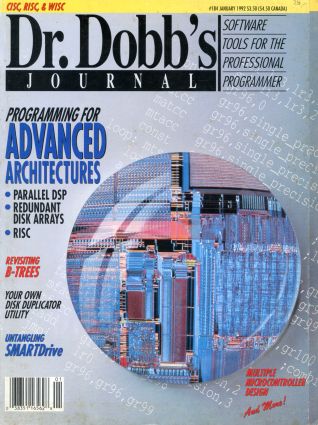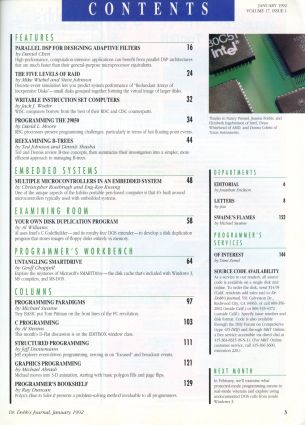
p.6 EDITORIAL
[author : Jonathan Erickson] #Edito
TABLE OF CONTENTS
FEATURES
p.16 PARALLEL DSP FOR DESIGNING ADAPTIVE FILTERS
[author : Daniel Chen]
High-performance, computation-intensive applications can benefit from parallel DSP architectures that are much faster than their general-purpose microprocessor equivalents.
p.24 THE FIVE LEVELS OF RAID
[author : Mike Wiebel and Steve Johnson]
Discrete-event simulation lets you predict system performance of "Redundant Arrays of Inexpensive Disks"—small disks grouped together forming the virtual image of larger disks.
p.32 WRITABLE INSTRUCTION SET COMPUTERS
[author : Jack J. Woehr]
WISC computers borrow from the best of their RISC and CISC counterparts.
p.34 PROGRAMMING THE 29050
[author : David L. Moore]
RISC processors present programming challenges, particularly in terms of fast floating-point events.
p.44 REEXAMINING B-TREES
[author : Ted Johnson and Dennis Shasha]
Ted and Dennis review B-tree concepts, then summarize their investigation into a simpler, more efficient approach to managing B-trees.
EMBEDDED SYSTEMS
p.48 MULTIPLE MICROCONTROLLERS IN AN EMBEDDED SYSTEM
[author : Christopher Rosebrugh and Eng-Kee Kwang]
One of the unique aspects of the Infolio portable pen-based computer is that it's built around microcontrollers typically used with embedded systems.
EXAMINING ROOM
p.58 YOUR OWN DISK DUPLICATION PROGRAM
[author : Al Williams]
Al uses Intel's C CodeBuilder—and its royalty-free DOS extender—to develop a disk duplication program that stores images of floppy disks entirely in memory.
PROGRAMMER'S WORKBENCH
p.64 UNTANGLING SMARTDRIVE
[author : Geoff Chappell]
Explore the mysteries of Microsoft's SMARTDrive—the disk cache that's included with Windows 3, MS compilers, and MS-DOS.
COLUMNS
p.97 PROGRAMMING PARADIGMS
[author : Michael Swaine]
Tiny BASIC put Tom Pittman on the front lines of the PC revolution.
p.103 C PROGRAMMING
[author : Al Stevens]
This month's D-Flat discussion is on the EDITBOX window class.
p.111 STRUCTURED PROGRAMMING
[author : Jeff Duntemann]
Jeff explores event-driven programming, zeroing in on "focused" and broadcast events.
p.121 GRAPHICS PROGRAMMING
[author : Michael Abrash]
Michael moves into 3-D animation, starting with basic polygon fills and page flips.
p.129 PROGRAMMER'S BOOKSHELF
[author : Ray Duncan]
Polya's How to Solve It presents a problem-solving method invaluable to all programmers.
DEPARTMENTS
p.8 LETTERS
[author : you]
p.152 SWAINE'S FLAMES
[author : Michael Swaine]
PROGRAMMER'S SERVICES
p.144 OF INTEREST
[author : Tami Zemel]
